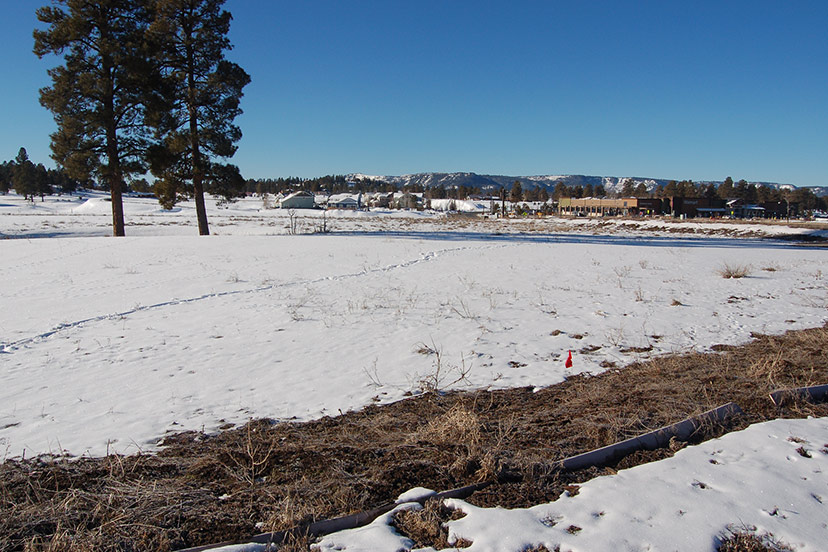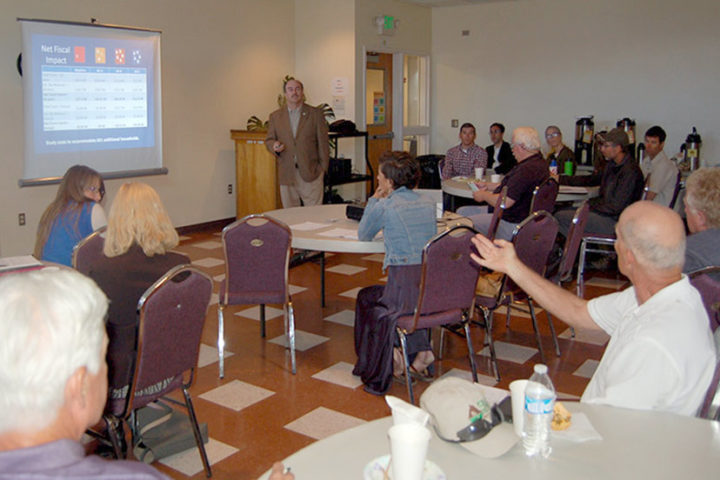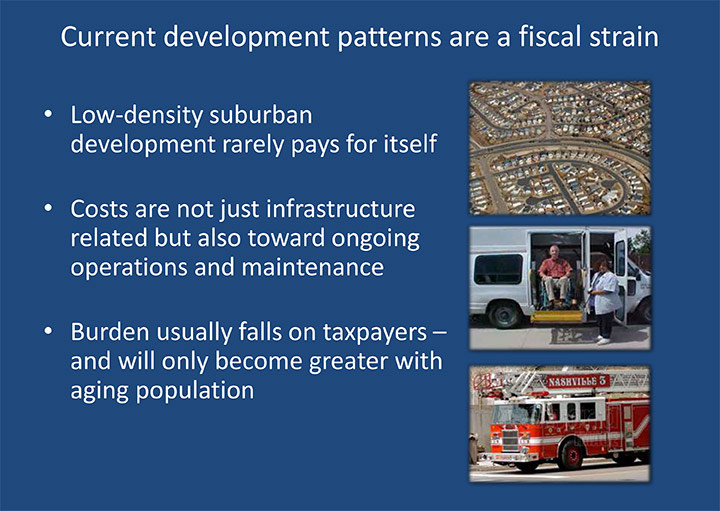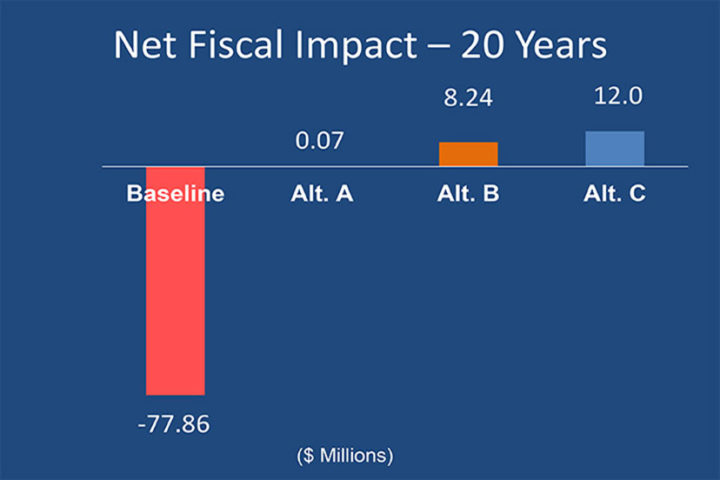We’ve shared a fair number of articles by Chuck Marohn and his team at Strong Towns, a national non-profit that advocates for sensible approaches to development — sensible in terms of socially beneficial neighborhoods, and perhaps even more importantly, sensible in terms of financial sustainability. Much of the infrastructure development that has taken place in the U.S. over the past 75 years has been unsustainable, and thus has been, essentially, a drain on the wealth of communities. The only way we’ve been able to finance this lifestyle has been through a massive increase in government, business, and personal debt.
Because a good deal of our infrastructure has had a useful life of 50 years or longer, we didn’t fully notice the hole we were digging for ourselves. And in a community like Pagosa Springs, where much of our development has taken place over the past 30 years, the investments and growing debt have been covered by population and tourism growth, in a sort of ‘government Ponzi scheme’.
When the financial house of cards will come falling down, no one knows. But the folks at Strong Towns consistently advocate for changing our behavior now, before disaster strikes.
Mr. Marohn is working on a series of books about more prosperous towns and cities, and the first one came out in 2021.
But new approaches to transportation infrastructure are only one aspect of a solution. Another aspect has to do with land use. And the avoidance of “land abuse.”
Now that I’m writing Part Ten of this editorial series, I realize that my headline… “Town Council Discusses Significant Property Purchase East of Downtown”… was, perhaps, misleading. It may have implied that the Town Council and Town staff have discussed the details of a proposed 35-acre property purchase — adjacent to a stagnant, proposed subdivision called Mountain Crossing — in public meetings. This has not, in fact, happened.
Nor has the Town had a serious public discussion about the best use of a potential $3 million “affordable housing” grant. Discussions by Town staff and by the Town Council, about the grant details, financial and otherwise, have taken place behind closed doors.
The 35-acre property in question has no streets, no utilities, no adjacent neighborhoods, no highway access, no retail access. Given those facts, I find it distressing that we’ve not had any public discussions at Town Hall about alternative, feasible ways to promote workforce housing using a $3 million grant.
In particular, I’ve not heard any discussions about numerous vacant parcels already available for purchase in Pagosa’s already-developed neighborhoods.
Yesterday, for example, I mentioned the residential parcels in the “Live, Work, Play” subdivision known as Aspen Village — a project that has remained largely vacant for the past 15 years.

Aspen Village already has streets… already has utilities… already has highway access, including a signalized intersection. It already has a neighborhood drainage plan that feeds storm water into an existing wetlands. It already has walking and biking trails… and sidewalks… and streetlights. It’s already home to the community’s largest retail store, within easy walking distance. It is also home to a neighborhood K-8 school, also within convenient walking distance. It’s at the west end of town, where 80% of the community’s population lives, and where most future residential development is likely to take place.
It already has many platted residential parcels, awaiting development.
In a sense, Aspen Village has everything that the Mountain Crossing property, at the east end of town, does not have.
Would it be vastly more intelligent to spend $3 million, helping to create affordable or workforce housing in an existing subdivision like Aspen Village… rather than building a competing development at the opposite end of town, using taxpayer money?
I feel compelled to ask this question, because no one at Town Hall seems willing to ask it.
We’ve discussed, in previous Daily Post articles, the Town’s grant-funded work with Smart Growth American, a corporation based in Washington DC that embraces some of the same philosophy as Strong Towns. The Smart Growth America consultants visited Pagosa in 2017, brainstormed with community leaders and developers, analyzed the best and worst options for further growth, and then provided the Town leadership with a couple of reports.
One aspect of the philosophy shared by Smart Growth America and Strong Towns (and the Daily Post) is that towns can grow in ways that enhance the community’s overall wealth… but that many American cities and towns have been growing in the opposite direction… in a direction that ultimately drains the community of its financial (and social) wealth.
That financially-damaging direction typically goes by the name: “sprawl”. It’s the general direction in which Archuleta County has been growing for the past 50 years.
Here are some slides from Smart Growth America’s 2017 Powerpoint presentation:
The photo above is meant to illustrate the worst possible style of development, if a community wants to remain financially viable. Obviously, the Archuleta County Board of County Commissioners didn’t understand the financial dangers of sprawl development when they approved subdivision after subdivision between the late 1960s and the late 1990s. We are now stuck with those decisions, and the social damage is most obvious in terms of 300 miles of poorly maintained roads, inefficient public transportation, overextended law enforcement, lengthy school bus routes, and now, more recently, skyrocketing home prices.
Smart Growth America summarized the same problems… noting that the burden “usually falls on taxpayers”…
They also summarized the strain placed on businesses and governments by our current “sprawl” development style. They analyzed the financial cost of sprawl — as practiced in Pagosa Springs over the past 50 years — and what it might cost the community if the same pattern were to continue into the future. The picture was not a pretty one, when comparing our current development style to development alternatives that make use of existing infrastructure and that encourage people to live, work, and play in more compact neighborhoods.
According to Smart Growth America’s calculations, our community will wind up $78 million in debt over the next 20 years by continuing our ostentatious, sprawling growth pattern.
There are alternative ways to grow a town. By making use of existing infrastructure and by encouraging denser and more sensible development — more families per square mile — our community could actually grow its wealth, rather than going further into debt.
As noted, this advice was delivered in April 2017. Something else happened at Town Hall, in 2017…






